
If you have been selling software for a while, you have probably built a considerable customer database. But to what extend are you taking advantage of that important asset?
How can you sell more stuff to your existing customers?
But before we move on to the HOW, let me first give you 3 reasons WHY you should sell more to your existing customers and some ideas on WHAT you could sell to them.
(this is a reworked and updated version of my presentation at the European Software Conference in London, November 2011)
Why sell more stuff to existing customers?
 Well, the short and simple answer is:
Well, the short and simple answer is:
to make more money.
But here’s the longer answer. 3 reasons:
It’s easy
Nothing’s easier than selling to existing customers. When selling stuff online, one of the main factors that impact conversion rates is trust. It’s hard to get people to trust you with their money, especially if you’re a small and relatively unknown ISV.
Not a problem when selling to people who have bought from you before. These people already know you, love you (I hope) and trust you to actually deliver the goods (because you have done so before).
It’s cheap
Acquiring new customers is expensive. You have to spend money on Adwords, adCenter and Facebook ads, spend time on SEO, or maybe even deal with pre-sales questions.
However, your existing customers can be reached for free, in various ways. Email being the most obvious choice.
BTW: even though the selling can be done for free, the creation of the “stuff to sell” is not without costs (with some exceptions, see below).
It’s good for you
And with you, I mean: your business. Consistently selling to your existing customers again will give your business more stability, continuity and value.
Think about it: what happens if your flow of new visitors suddenly decreases or even comes to a halt? Google may drop your website from the organic results or they may ban your Adwords account. If your entire business consists of selling one product to new customers, your income will immediately drop to next to nothing.
On the other hand, if you are consistently selling upgrades, add-ons, subscriptions and other products to your existing customers, your business will go on, and you will still be able to pay your bills. Of course, if the traffic problem persists, that will taper off too, but you will at least have some buffer to do something about them.
Also, by having a continuous flow of income from a substantial customer base, you are creating value in your business. Your customer base will become your most important asset, especially if you can create an automatic source of recurring revenue (subscriptions!).
What can you sell to existing customers?
 We’re in the software business. We sell software, not jars of peanut butter that need to be replaced when empty. For most of us holds: once people buy our software, they can use it for the rest of their life.
We’re in the software business. We sell software, not jars of peanut butter that need to be replaced when empty. For most of us holds: once people buy our software, they can use it for the rest of their life.
So if you want to sell again to the same people, you will have to come up with something new. Here’s some stuff you can sell to people who have already bought your software:
Subscription services
The easiest way to make your software more like that jar of peanut butter:
Sell it as a subscription service. Or create a new subscription service that you can sell as an add-on to your “pay once for life” software.
With our Collectorz.com Connect web-app we did both. Connect is both a stand-alone web-based cataloging tool and an optional add-on for users of our desktop software.
Paid upgrades
The next best thing and the most natural way to sell again to your loyal users: charge for your software updates. You’re constantly improving and updating your software anyway, so the extra costs are low. Just combine several big new features and improvements in a major upgrade, and your users will be happy (even expecting) to pay for it.
If you’re not doing paid major upgrades, you’re leaving a lot of money on the table. We only starting doing this in our 7th year (!!), in 2007. It was a huge jump for our company, not only in profits but also in the quality of our software. Somehow, preparing a major upgrade that your users have to pay good money for really gets the creative juices flowing. And the extra money makes sure you have the resources to implement your new ideas too.
Plug-ins and add-ons
If you’re planning to add a new piece of functionality to your software, especially if it’s an exotic or advanced feature, consider making it into into a plug-in or unlockable feature that you can sell to your users. The App Store’s “in-app purchases” are a good example of how well this system can work.
Alternatively, create additional add-on software that closely works together with / connects to your main product, e.g. an import/export tool or a mobile app.
For example, our CLZ mobile apps are add-on apps, that let desktop users export then view their collection database on their mobile device.
In general, plug-ins and add-ons should contain functionality that is only needed or wanted by a subset of your audience, in most cases the more advanced users. Otherwise, you’re better off including the functionality in your main product.
Related software
This is the most expensive and time-consuming “stuff” to create, but can be well worth it.
With related software, I mean new stand-alone software products targeted at the same audience as your existing product. Cross-selling related software is not as easy as up-selling to add-ons, but it still gives you a ready-to-go audience to sell to.
For example, if you’re selling a HTML-editor tool, you may want to create an FTP client.
Or, if your main product is CD cataloging software, consider developing similar database programs for DVDs, books, comics or video games 🙂
Priority support
Priority customer support may be the cheapest “stuff” that you can sell to existing users. You are providing excellent support to your users anyway, so why not make some extra money doing it. Some customers are happy to pay for a “response within 24 hours” guarantee. If you’re selling to businesses, many will even expect to have to pay for support. So don’t disappoint them 🙂
Hardware
And finally, you could sell hardware and other physical items that relate to or work with your software. Selling hardware is not exactly risk or hassle free, as you have to invest up-front, manage your inventory, deal with warehousing and shipping costs, etc… However, you can test the water by selling the items through an affiliate or drop shipping system first. Then if it’s successful, you can start taking stock yourself, and increase your margins.
At Collectorz.com, we have been quite successful selling barcode scanners. We started out with just one scanner, but are now selling 3 different scanners in 3 price categories. We buy them in large quantities to get the costs down and make a healthy margin.
How to sell more stuff to your existing customers?
 So far for the why and the what. On to the most interesting part: the how.
So far for the why and the what. On to the most interesting part: the how.
Because new stuff doesn’t sell itself. Just putting it in your shop is not going to work.
To actually sell your new program, upgrade or add-on to your existing customers, you need to do three things:
- Create awareness: The minimum you need to do is make people aware of your new stuff. If they don’t know it exists, they won’t buy it.
- Ask for the sale: Then, at some point, you need to be blunt and just ask for the sale. Tell people to buy now and explain how to.
- Remind them: Finally, keep reminding them. Don’t just do a happy “it’s live!” email once and expect everyone to purchase. You need to remind them, again and again.
Now, let’s look at ways you can do all three. The obvious choice is to use email, but it certainly isn’t the only way:
Your website
Start creating awareness of your up-sells and cross-sells right on your landing page. Let your new visitors know it’s there for them, even before they buy your main product. The existence of the extras may even help sell your main product.
In any case, don’t hide your extras in your shop.
In your software
Goal: awareness
For add-ons, mobile apps or hardware that connects with your main product, a natural place to create awareness is inside your software itself. A simple link to your website for more information is enough.
For example, this is the Add screen of our Book Collector product.
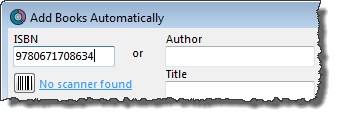 The “No scanner found” message is also a link to a page on our website that explains the advantages of adding books using a barcode scanner.
The “No scanner found” message is also a link to a page on our website that explains the advantages of adding books using a barcode scanner.
Facebook page
Do you have a Facebook page for your company? Or maybe for your product? Posting updates there is a nice extra way to reach your customers. The advantage of Facebook updates is that the annoyance threshold is much lower than for email. You can easily post 2 or 3 updates a day without anyone being annoyed.
You can use updates to post user stories and testimonials (for awareness, reminders), progress updates (for pre-launch awareness), announcements, etc… Here’s an example of a progress update post. Note the link to the product page and how we use the names of our programmers to make it more personal.
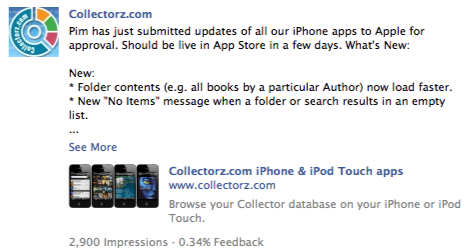
Goal: awareness / reminders
Twitter can be used in the same way as Facebook, though it’s a slightly different audience. While Facebook works well for consumer-type products, Twitter seems to be more suited for business/professional software.

Tip for both Facebook and Twitter: if you have a longer story to tell, put it on your website (or your blog) and include a link in your tweet or FB update. That way, you get people back to your website, where your up-sells are. On our Collectorz.com blog, we always list our current offers in a panel to the right of the blog post.
Facebook Fan Ads / Customer Remarketing
Goal: awareness / reminders
This may sound crazy, because one of the WHY’s I mentioned above was that selling to existing customers was cheap. But if you have valuable extras to sell, it may make sense to advertise to your own customers, that is, with paid ads. Just as an extra way to reach them.
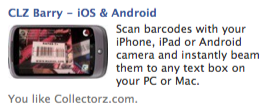 Facebook fan ads (Facebook ads targeted at people who like your page) work well for this and are relatively cheap:
Facebook fan ads (Facebook ads targeted at people who like your page) work well for this and are relatively cheap:
A 2nd paid method for reaching your own customers is remarketing. Just create a customer audience by cookie-ing people on your “Thanks for your purchase” page, then target that audience with up-sell banners.
Email Marketing
![]() The above channels are all great for awareness and subtle reminders, but email marketing is still the best way to create awareness, send reminders and to make the actual sale. Here’s four powerful ways to use email:
The above channels are all great for awareness and subtle reminders, but email marketing is still the best way to create awareness, send reminders and to make the actual sale. Here’s four powerful ways to use email:
Monthly newsletter:
Goal: awareness / reminders
If you wanna sell more to your customers, the absolute minimum you need to do is remind them of your existence once in a while. In a monthly newsletter you can do subtle reminders by writing about the past months’ releases, including small maintenance builds. Create pre-launch awareness by including news about your progress on new products and updates.
A newsletter is not the best place to ask for the sale. If you want another chance to sell a new product, I would suggest to be more subtle about it and just repeat the announcement, linking to the product page for more information.
Pre-launch “Preview Clubs”
Goal: awareness / ask for the sale
 A Preview Club is a form of list segmentation used for product launches and major upgrades, a way to send specific emails only to people that are interested in receiving them. A couple of weeks before a product launch, you send out an email to your entire list, announcing the new product and inviting everyone interested to join your Preview Club. They can do so by clicking a special link that tags them as a member.
A Preview Club is a form of list segmentation used for product launches and major upgrades, a way to send specific emails only to people that are interested in receiving them. A couple of weeks before a product launch, you send out an email to your entire list, announcing the new product and inviting everyone interested to join your Preview Club. They can do so by clicking a special link that tags them as a member.
In the weeks before launch, club members receive extra emails, feeding more information, sneak preview screen shots, Q & A’s, etc… The club emails tell them everything they need to know to make their buy/upgrade decision. For example, here’s the Sneak Preview Page that we used for the Movie Collector 8 for Mac preview club.
Then on launch day, many club members will be anxiously refreshing their inbox waiting for your launch email, credit card in hand. So in your “IT’S LIVE” email, you can be to the point and just ask for the sale.
After launch, don’t throw away your valuable club list. Not everyone will immediately buy on launch day. Don’t hesitate to send them at least 3 reminders, e.g. 5 days after launch, 4 weeks after launch, 3 months after launch.
Pre-launch clubs let you get away with frequently emailing certain users (up to twice a week even!), without annoying anyone. For Collectorz.com, “clubs” have been very effective in increasing the sales numbers for upgrades, new products and add-ons. They’re also a good way to judge interest before launch, so that you can know what to expect in terms of sales.
Sales campaigns
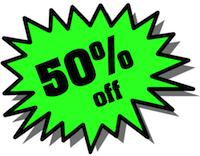 Goal: ask for the sale / reminders
Goal: ask for the sale / reminders
Finally we get to the hard sales push :-).
Sales campaigns are great to generate a lot of sales in a short period of time. Discount one of your products for a week and let your users know about it by email.
Some tips to optimize your results:
- Discount: The discount you’re giving should be considerable, at least 30%, maybe even 50%. It’s not worth (ab)using your list for a small 10% discount.
- Urgency: Have a hard deadline that is not too long away, say 1 week, to create urgency. And be as clear as possible about the end date, repeating it in different wordings, e.g. “This offer ends on April 8, 23:59.”, “2 days left” and “on April 9, pricing will be back to normal”.
- Scarcity: If you can, create more urgency by scarcity. “54 items left” is a clear and understandable incentive for users to act now. Using scarcity is most natural when selling hardware (limited stock). But it can also be used for digital goods, e.g. by saying “The first 250 buyers will get an extra 10% discount”.
- Peer pressure: Help people decide by showing them that many other users went before them. Especially effective in reminder emails (“Since the start of Book Collector week, 327 of your fellow users have taken us up on this offer”).
- Reminders: Don’t hesitate to send multiple reminders during the discount period. In any case, always send a reminder email on the last day. We have found that a short “x hours left” email always generates a sales spike at least as high as first day spike.
Here’s the results of an “Upgrade Week” we did between May 11 and May 16 2010. I have include some extra days from before the Upgrade Week, so that you can better see the effects of the offer and the 2-days-left reminder.
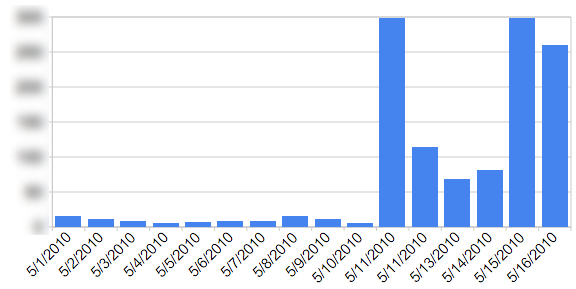
Auto-responders
Goal: reminders / ask for the sale
After new customers purchase your main product and have been using it for a while, you want to remind them of the add-ons and other products you have available for them. Now you can of course send a broadcast email to your entire list once in a while, but that is sure to annoy many people.
The solution here is to use an auto-responder sequence for customers, a predefined set of emails that is sent to customers on a preset numbers of days after their purchase. This gives you the ability to perfectly time your messages in relation to how long they have been using your main product.
For example, this is our auto-responder sequence for people who buy our DVD cataloging product Movie Collector:
- Day 0: Thanks for purchase, link to “Getting Started” guide.
- Day 7: How to speed up your cataloging with a barcode scanner.
- Day 15: Your collection cataloged? Use the CLZ Movies app to view it on iPhone.
- Day 60: What about your books, CDs, games and comics?
Summary and warning
To summarize the above:
- Come up with stuff you could sell to your existing customers. Think about add-ons, related products, hardware?
- Instead of adding the next advanced feature to your existing product, consider creating a new add-on or product that you can actually ask money for.
- When selling that upgrade, add-on or new product: build awareness, push the sale (hard) and keep sending reminders, again and again and again and again.
- Use multiple “channels” to reach your customers. Don’t limit yourself to just email.
And a warning:
Selling more stuff to existing customers is a great way to make more money. But do not underestimate the importance of continuously attracting new customers. The better you get at selling to your existing customer base, the more important it becomes to grow that list. Don’t forget that while you’re adding new names to the top of the list, others will be falling off the bottom. If your add-rate slows down, your list may be shrinking.
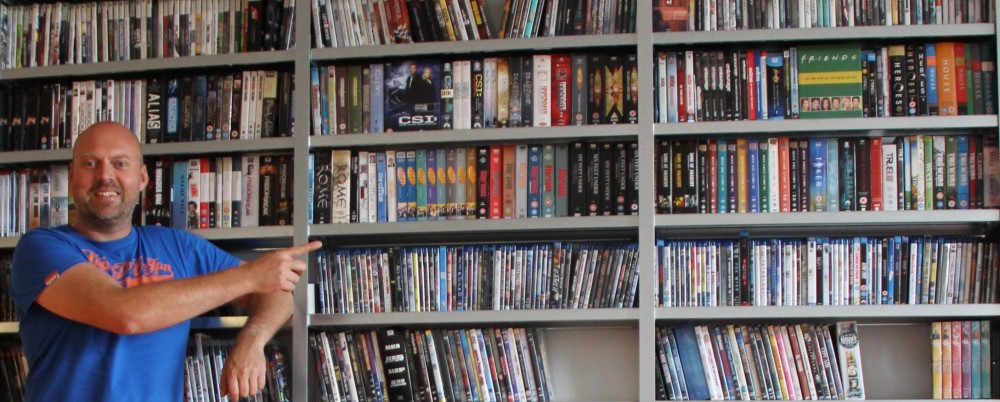

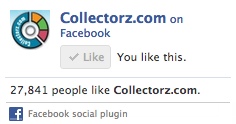
Even better now, Alwin. Actually I believe that your presentation at the ESWC are always highlights in quality and practicality.
Good story Alwin!